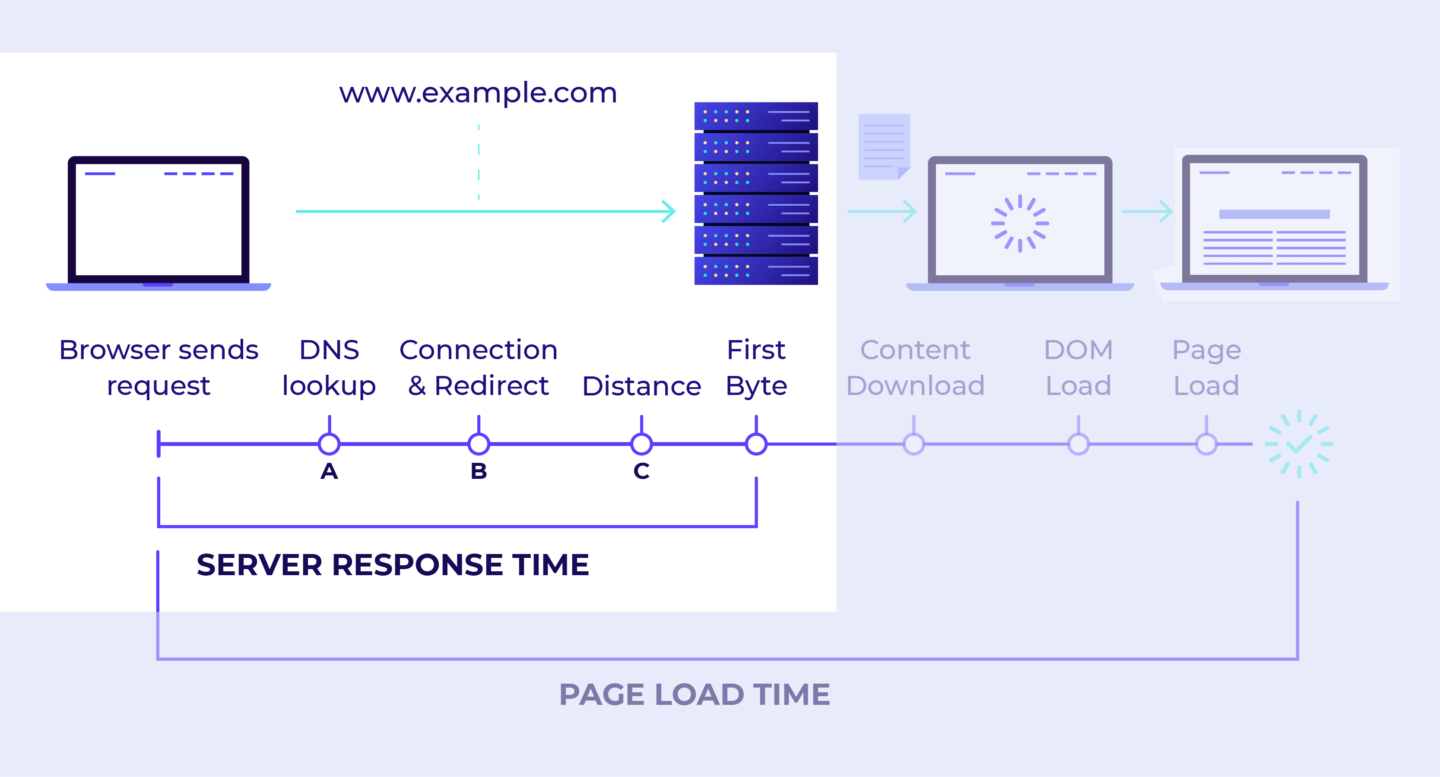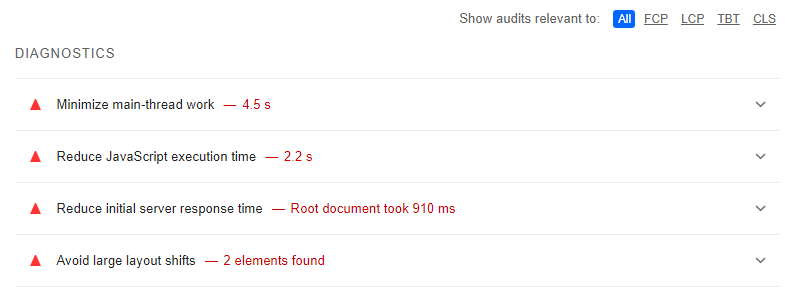
In the context of WordPress sites, understanding how to minimize the initial server response time, often referred to as Time to First Byte (TTFB), is a major factor that improves user experience.
In this article, we will discuss what TTFB is, why it is important, and what causes a slow Server Response Time. Moreover, we will provide ways to check the TTFB value of your website and reduce it if necessary. So, let’s dive in.
Server Response Time
The Server response time refers to how long it takes for a web server to respond to an HTTP request from a client’s browser. This amount of time is also known as Time to First Byte (TTFB). It is considered a critical metric for website performance, as it impacts how quickly a webpage begins to load.
What Is Time to First Byte (TTFB)?
To put it plainly, TTFB is the time between the moment a user initiates a request to a web server and the moment the server starts sending the first byte of data back.
We could depict and describe the process in more detail like this:

1. User Sends a Request
It all starts with the browser triggering an HTTP request. This is where the measuring of Time To First Byte (TTFB) also starts. The amount of time it takes until it reaches the server depends on several factors related to the user’s network and the connection:
- The time it takes to perform a DNS lookup
- the speed of the user’s network, any redirections or connection disruptions that may occur
- the distance between the user and the server
About the DNS lookup: When you type a website address like “www.example.com” in your web browser, your browser has to figure out the actual location of that website on the internet. It’s like finding the right phone number for a friend. This finding process is called DNS resolution. If your browser doesn’t already know the location (IP address) of the website, it asks special servers (DNS) on the internet for help. These servers work like an address book to provide the correct location, so your browser can connect to the website. You can read more about this in our dedicated article on how DNS works.
2. The Server Processes the Request
Upon receiving the request, the web server begins processing it. This includes parsing the request and deciding what action to take. To gather the necessary data, the server may have to communicate with the databases or other resources. Then it prepares the content that needs to be sent back to the user. The generated response content could include HTML, images, scripts, and other resources that the webpage may require to render.
3. The Server Responds
Next, the server creates the response and sends its first Byte back to the user.
The “first byte” refers to the initial portion of the response data. It might be part of the HTML document or a key resource needed for rendering, such as an essential CSS file or a critical script.
This is where the TTFB ends. Thereafter, the server will continue sending the response data to the browser. The browser will interpret the data accordingly and render it to properly display the content.
Why is Server Response Time So Important?
Because it directly affects visitors’ experience and engagement.
Since it is part of the website loading, Time to First Byte impacts speed. If TTFB is a large value, the user waits longer for the page to load. This negatively affects user experience and consequently, may cause bounce rate to increase and impact your Ranking and SEO as well. It’s no accident that Time to First Byte is closely related to Largest Contentful Paint (LCP), which is one of the three Core Web Vitals metrics.
NOTE: Even though TTFB is an important measurement, it focuses on how long it takes for the server to respond. However, the experience of real users also depends on the whole process taking place after the initial response which is more related to the total time page content is displayed in your web browser. Rendering of content, interactivity, and visual stability, play a much more significant role in how users appreciate their experience.
This is the reason TTFB, being a less user-centric metric, is not included as a stand-alone CoreWeb Vital.
What Causes a Slow Server Response Time?
Various factors can lead to slower server response times.
An underperforming server will be rather overwhelmed by a sudden spike in website traffic and give a slow server response.
It is possible that the website is using a hosting provider that has limited hardware resources (lack of CPU, RAM) or has outdated hardware or lack of scalability. Such servers are usually overcrowded and cause slow server responses.
This may also happen because of unoptimized server configuration:
- Outdated software versions (Apache, Nginx, PHP, Python)
- Caching mechanisms misconfiguration.
- Insufficiency of the simultaneous and maximum connections the server can handle (Concurrency).
- The compression methods that are used.
- Keep-Alive settings.
- Security settings, HTTP/2 protocol, TLS/SSL encryption.
- Unnecessary complexity of authentication processes.
- Network and client-to-server distance.
These are only some of the server configuration settings that could cause a slow response. So, be patient and extensively research before purchasing a hosting service.
Slow server response times can happen because of slow MySQL query responses. This delay makes the server slow in returning the requested data. This is a sign that the database requires optimization.
Suboptimal Code, like clunky scripts coming from a plugin or custom coding, can put a significant burden on how fast the server responds.
This kind of code makes the server work harder, slowing down how quickly it can handle requests.
For example, a missing index in a database query would result in an unnecessary full table scan, which can be time-consuming especially as the size of the table grows. Another common bad practice is when the code waits for the external request to complete before continuing with the HTML generation process. This can significantly slow down the page load time if the external API is slow to respond or experiences downtime.
Suboptimal images that are large in size because of no or bad compression will take longer to be transmitted from the server to the user’s browser.
Four Ways to Check TTFB Value on a WordPress Website
Measure TTFB With Chrome Dev Tools
This advanced developer tool that Chrome provides can help you dig into the flow of how your website’s content elements load. That includes measuring the Time To First Byte.
While viewing a page, press the F12 button (or right-click -> inspect).

Then select the Network tab and go to Doc.
Currently, you see no information. You have to reload the page. Once the page is reloaded, find the document request, and on the right panel, open the Timing tab, and then check the “Waiting for server response” value

The ideal server response time is less than 100-200 milliseconds.
NOTE: When measuring the server response time shown in Dev Tools, network latency, caching and other client-related factors may affect the results.
Measure TTFB With Lighthouse
Lighthouse is a powerful and open-source tool developed by Google. It can help you audit and improve the quality of web pages by providing various performance metrics, including TTFB. On top of that, you can use it directly in your browser’s DevTools.
In Chrome, for example, press F12 and navigate to the “Lighthouse” tab. Choose the desired options (Mode, Device, Categories, Plugins) and then hit the “Analyze page load” button.

Once the audit is complete, you will see a detailed performance report. Under the “DIAGNOSTICS” section, you can find the “Initial server response time” measurement.
Measure TTFB With Pagespeed Insights
Google’s Pagespeed Insights (PSI) is another great tool to help you measure TTFB. Not only will you get the results, it will also recommend improvements.
Enter the desired URL and view the Performance report. It’s a brief analysis of both mobile and desktop versions of your website.
Then find the “Diagnostics” section where there is a subsection called “Initial server response time.“

This is where you can find the TTFB value measured in milliseconds.
NOTE: Keep in mind that this is a single test. That means the more times you run the test, the more accurate the results. Measuring performance with PSI is an invaluable skill. It can save you from lots of trouble and help you improve the overall user experience.
Measure TTFB With WebPageTest
Another great and free tool you can use to measure TTFB -among other things- is WebPageTest. It allows you to perform an in-depth analysis of your website’s activity and get a quick feel for whether or not your site is working well and whether there is a need to look more closely at how it is performing.
You can consult our comprehensive guide on how to do performance analysis with WebPageTest where we break down all the results and also show you where you can get the TTFB value of your tested webpage.
📋 Free PDF Download: Test & Measure Speed Checklist. A step-by-step tasks list for PSI, GTmetrix, WebPageTest, plus a simple results log.
How to Reduce Initial Server Response Time on a WordPress Website
To help optimize your load times and reduce the Time To First Byte as much as possible, you can follow these strategies:
Move to a Managed WordPress Hosting Service
The best way to reduce the initial server response time is to use an advanced hosting service if you already don’t. We advise that you take your time to evaluate the WordPress hosting provider you are about to migrate to and choose the right hosting plan for you.
Many features an advanced server provides will be crucial in improving TTFB, like the request processing mechanism, caching, firewall and more. Also, location selection in terms of the geography of your traffic is really important. When you distribute your content across multiple servers in different geographic locations, you reduce the latency upon the requests because the distance between the server and the end user decreases.

Additionally, another bonus of using an advanced WordPress hosting provider, is that the solution should be engineered to provide you with hardware and software that is already optimized for high-performance and lightning-fast back-end requests.
📋 Free PDF: Get your hosting buyer’s Checklist. Learn what to look for when choosing the right hosting type and plan. Use the 8 essential questions to evaluate migrations, backups, surge handling, and support depth.
Use a Content Delivery Network (CDN)
The main way CDN technologies improve TTFB values is by lowering the geographical distance between the hosting server and the target audience when requesting media files. Content Deliver Networks store copies of your static assets to their edge servers, and each time they automatically choose to distribute from their edge location closest to the requesting user.
Try our Award-Winning WordPress Hosting today!

Minifying Your Scripts
You can reduce the size of your code and the number of JavaScript, and CSS files by compressing them without compromising performance.
Optimize Your Images
Compress your images to reduce their file sizes. Luckily, there are ways to optimize your images without compromising their quality. You should also benefit from modern image formats like WebP, which offer better compression.
📋 Free performance PDF: Client-Side Optimization Quick Wins. A concise checklist that helps you apply quick front-end optimizations to improve load speed and user experience.
Use Server-Side Caching
Caching has a major impact on reducing TTFB values. Your best choice when utilizing caching is to go with server-side caching. At Pressidium, we have dedicated ourselves to providing a multilayered caching mechanism that will increase overall cache-hit ratios and make your site perform significantly better, while simultaneously helping reduce TTFB to the maximum extent.
Optimize SQL Queries
Identifying and enhancing slow database queries is another great way to help with TTFB issues. There are lots of ways to speed up your website’s database. You will have to first identify the slow queries and then optimize them. You may also need to create indexes, modify your site to use object caching, defragment your database, or take other more advanced measures, such as custom fields and table structures.
Avoid Themes and Plugins Overuse
One of the most important best practices is to try to keep your website simple by using well-built, pre-optimized themes and the smallest number of plugins possible. You should check that they are not highly resource-consuming by using a monitoring plugin and deleting the unnecessary ones. We also recommend updating them often to benefit from any performance improvements and security fixes.
📋 Free PDF: Server-Side Performance Optimization. Follow a step-by-step checklist for caching, PHP tuning, compression, and scaling. Perfect for ensuring your hosting stack is optimized for lightning-fast response times.
Avoid multiple redirects
You may have noticed that sometimes you visit, let’s say http://this-site.com and the server responds with a redirect to https://this-site.com and then another redirect to https://this-site.com. This can be merged into one redirect to reduce TTFB values.
Use the early hints (HTTP status 103) techniques to get hints about the sites and resources that the server is expecting the final response will link.
Avoid blocking for external resources
Let’s say that you visit a website which, somewhere in its code makes a request to another external website to fetch data to display in the generated HTML. That means that loading will hold and be blocked until the external data is retrieved, and if, for some reason, the other site is down, your requests will wait until the request times out.
Optimizing your server response time is crucial for better performance. If you want a comprehensive review of your website’s performance, we offer a free performance audit. Click the banner below to get started and ensure your site is running at its best!

Frequently Asked Questions
What is a Good Server Response Time?
A good server response time, often referred to as Time to First Byte (TTFB), is typically less than 100-200 milliseconds. This means that when a user’s browser sends a request to your server, the server should ideally respond within 100-200 ms.
How to Reduce Initial Server Response Time With a WordPress Plugin?
You can install and activate a plugin such as WP-Optimize. Its features will help you clean your database by removing unnecessary data. Things like transients, spam comments, options, and pingbacks will slow down db queries and therefore impact server response time by increasing Time To First Byte (TTFB). WP-Optimize can also defragment and compress your MySQL tables to improve the efficiency of your database.
A well-known caching plugin such as WP Rocket can really come in handy as well. The features it provides, such as page caching, browser caching, CSS Minification, JavaScript, and HTML files, GZIP compression, and image lazy loading will speed up initial page rendering.
This article is part of our comprehensive performance series, focused on identifying and fixing key WordPress speed bottlenecks.
See Also
- What is Performance Testing?
- Measuring Website Performance: Tools
- WordPress Performance: Database Clean Up and Optimization
- HTTP Compression
- Measuring Website Performance: PageSpeed Insights Analysis
Want to fix every performance bottleneck methodically?
Read the full WordPress Performance Optimization Guide online for testing strategies, server tuning, and action steps.
No downloads. No email. Just free, in-depth content.
Conclusion
Understanding and optimizing Server Response Time (Time To First Byte – TTFB) is crucial for your website’s performance. We discussed how factors like network speed, server efficiency, and code optimization impact TTFB and what you can do to measure and improve it.
Hopefully, now after reading this article, you have gained valuable insight into improving TTFB values, and we’ve helped you demystify the concept.
Start Your 14 Day Free Trial
Try our award winning WordPress Hosting!



















